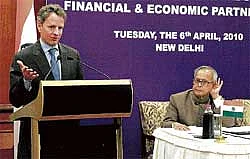

The India US Financial & Economic Partnership (IUFEP), which intends to focus on three broad areas—macroeconomic policy, financial sector reforms and infrastructure financing—was formally launched by the visiting US Treasury Secretary Timothy Geithner and Finance Minister Pranab Mukherjee here. The partnership will meet once a year alternating between the US and India.
Advance discussions
Working group and high official level meetings will be held during the year to advance discussion on specific economic policy areas.
Officials of both sides said the partnership would primarily work towards enhancing Indo-US cooperation on key economic areas like financial sector reform and infrastructure investment.
“India and the US have significant infrastructure needs. We aim to share experiences and intend a robust and ongoing dialogue on the potential for private public partnerships to unlock financing for critical infrastructure investment,” a joint statement said.
Greater access
Later briefing reporters, Mukherjee said “India offers immense investment opportunities in infrastructure sectors. Investment to the tune of $600 billion can be made in sectors like ports, communication and roads in the next 5 years.” The US has separately been demanding greater access to the India’s financial services market, including insurance — which could be used to fund infrastructure.
At present, foreign direct investment in the insurance sector is capped at 26 per cent. Geithner said “US is keen on deepening its ties with India. Enhanced economic ties will also facilitate more trade, investment and job creation in two countries.” He also praised resilience of Indian economy saying “India has navigated the financial crisis with a steady hand and has emerged from the global recession stronger and faster than other big economies.”
Asked about US expectation from India to boost investment in latter’s infrastructure sector, Geithner said during discussions the Indian side outlined the opportunity and challenges ahead for the Indian economy and policy reforms that were being undertaken to boost economic growth. The bilateral trade between the two countries in 2008-09 was about US$40 billion.
